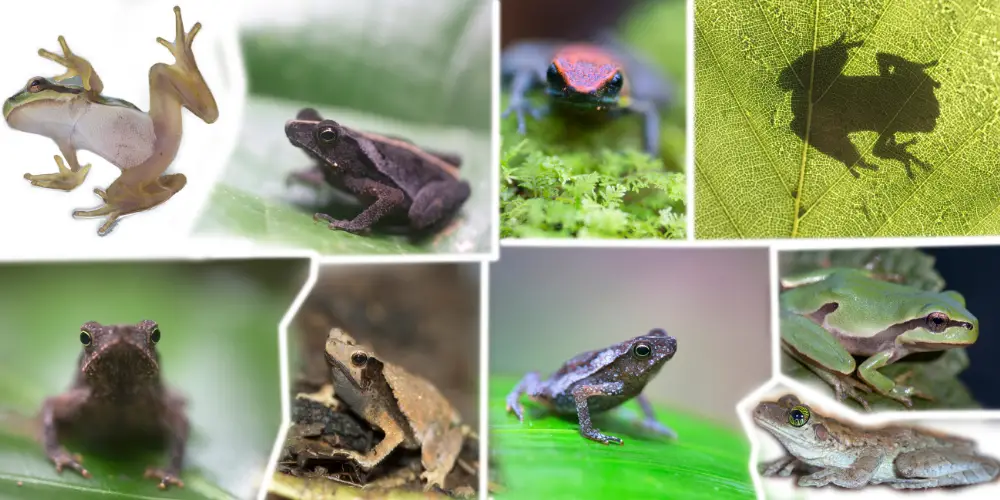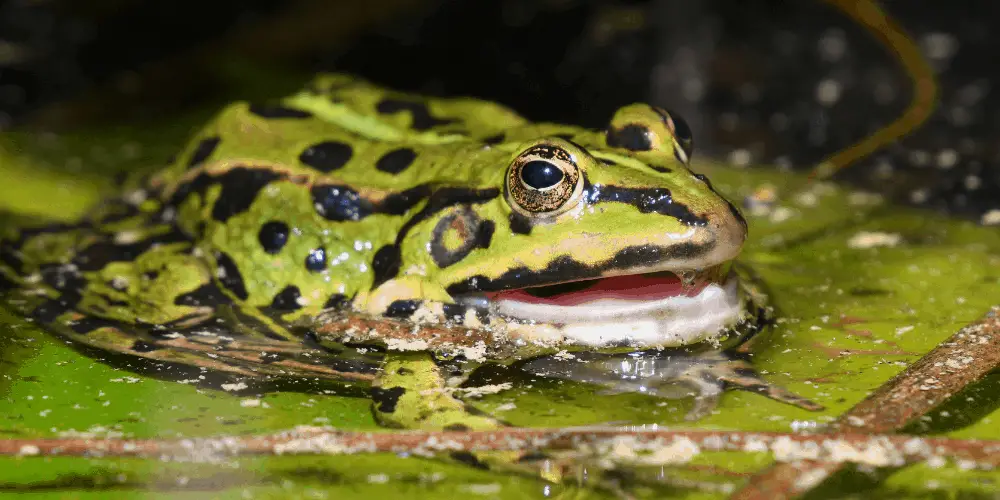Frog species captivate people worldwide with over 7,000 fascinating varieties.
As amphibians, frog species play integral ecosystem roles, provide research insights, and inspire mythology.
This guide explores frog species’ diversity, habitats, life cycles, conservation status, cultural significance, and care as pets.
What Makes a Frog?
The order Anura contains all living frog species. The name Anura comes from the Greek words “an-” meaning without and “oura” meaning tail, reflecting that adult frogs lack tails. Other distinguishing features include:
- Tailless, short bodies: Frogs have short, compact bodies with no visible tail. Their body plans are adapted for jumping and swimming.
- Diverse habitats: While some species live primarily in water, others occupy terrestrial, arboreal, or fossorial (burrowing) habitats. Frogs thrive in environments ranging from rainforests to deserts.
- Smooth, moist skin: A frog’s skin is smooth, moist, and permeable, allowing them to breathe and absorb water through their skin. Their mucus coating helps keep their skin wet.
Frogs are often confused with toads, but these two groups have no formal distinction.
Generally, toads have thicker, drier skin and are more terrestrial, while frogs have smoother, moister skin and are more aquatic. However, many exceptions blur this simple differentiation.
The Diversity of Frogs: An Overview
With over 5,000 described species, frogs display remarkable diversity in size, appearance, and habitat. For example:
- Size: Frogs range from the tiny gold frog (Psychrophrynella minuta), which is less than 10 mm long, to the goliath frog (Conraua goliath), which can reach 32 cm (12.6 inches).
- Distribution: While frogs live on every continent except Antarctica, tropical regions like the Amazon have the richest frog diversity. Still, frogs adapt to an impressive variety of habitats.
- Ecosystem roles: Frogs occupy an integral position in food chains and webs. As predators of insects, smaller frogs, and other invertebrates, they help regulate prey populations. And as prey for snakes, birds, mammals, and other frogs, they transfer energy through the ecosystem.
- Threats: Pollution, climate change, habitat destruction, invasive species, overharvesting, and infectious diseases threaten frog populations worldwide. Over 40% of frog species are declining in numbers. Protecting frog diversity is essential for ecosystem health.
Spotlight on Frog Families
The order Anura contains 54 extant families displaying incredible diversity. Some of the largest and most recognizable frog families include:
Poison Dart Frogs (Dendrobatidae)
- Description: Small, colorful frogs of Central and South America, famous for their toxic skin secretions.
- Unique traits: Their vibrant coloration warns predators of their toxicity. Each species has a unique skin toxin.
- Habitat: Tropical rainforests. Active by day, they are easier to spot thanks to their bright warning colors.
B. Tree Frogs (Hylidae)
- Description: Arboreal frogs with specialized toe pads to climb vegetation. Medium-sized with long legs.
- Unique traits: Exceptional jumpers and climbers. Many change color to camouflage with their surroundings.
- Habitat: Forests and jungles globally. Most live in trees near temporary pools or slow streams.
C. True Frogs (Ranidae)
- Description: Aquatic frogs with smooth, moist skin and powerful hind legs for swimming and jumping.
- Unique traits: Highly aquatic lifestyle. Their tadpoles have specialized mouthparts for scraping food from surfaces.
- Habitat: Freshwater wetlands and slow rivers globally. Includes common species like bullfrogs.
D. More Families to Explore
Many lesser-known frog families contribute to global diversity, like South America’s marsupial frogs (Hemiphractidae) and the narrow-mouthed frogs (Microhylidae) of North America, Eurasia, and Africa.
Discovering new species from remote regions remains an exciting area of research.
Conservation Status: Threats Facing Frogs
While frogs are survivors over hundreds of millions of years of evolution, today they face an array of serious threats from human activities:
- Habitat loss: Draining wetlands, deforestation, and urbanization destroys frog habitats. Aquatic species are especially impacted.
- Pollution: Fertilizers, pesticides, chemical runoff, and sedimentation of waterways poison frogs and their prey.
- Invasive species: Introduced predators like fish, bullfrogs, and crayfish eat native frog species, often causing population declines.
- Climate change: Changing rainfall patterns and increased droughts reduce breeding habitats and food sources for frogs.
- Infectious disease: The lethal chytrid fungal pathogen has caused mass mortalities of frogs globally. Climate change aids its spread.
These threats have contributed to the declines and even extinctions of hundreds of frog species, with over 40% now threatened.
Protecting remaining healthy habitats is crucial for frog conservation.
Fascinating Frog Facts
Beyond threats, frogs showcase a spectrum of fascinating behaviors and adaptations:
- Camouflage: Many frogs blend expertly into their surroundings, aided by skin color-changing abilities in some species.
- Poisonous skin: The vivid colors of poison dart frogs warn predators not to touch their toxin-coated skin, which can cause paralysis and death.
- Parental care: Some tropical frogs protect their eggs, transport tadpoles on their backs, or feed them with unfertilized nutrient-rich eggs.
- Hibernation: Temperate frogs survive cold winters by partially freezing themselves, allowing their vital organs to remain safely inactive but undamaged.
- Jumping and climbing: Powerful hind legs, elongated ankle bones, and specialized toe pads allow certain frogs to excel at jumping (50 times their body length!) and climbing vegetation.
Identifying Frogs: A Guide to Common Species
While identifying exact species can be tricky, even novice observers can recognize broader groups.
Useful distinguishing features include size, markings, and extent of webbing on the feet:
Common Frog Species in North America
- Green frogs: Medium-sized, greenish, or brownish frogs found near permanent ponds and lakes. They make a short, guttural croak.
- Bullfrogs: Huge green or brown frogs of eastern North America. Males have a loud, bellowing call. They are ambush predators.
- Northern leopard frogs: Named for their leopard-like spots, these medium-sized light brown frogs have a snore-like call. They inhabit wetlands and grasslands.
Exotic Frogs of the Rainforest
Tropical regions host preposterous shapes and colors:
- Poison dart frogs: Tiny but visible thanks to bright warning colors like red, yellow, green, blue, or orange. All species are toxic.
- Red-eyed tree frogs: Bright green arboreal frogs with blue-and-yellow side stripes and red eyes. They have sticky toe pads for climbing.
- Wallace’s flying frog: These tree frogs have extensive foot webbing, allowing them to glide up to 15 meters between trees. Found in Southeast Asian rainforests.
Rare and Endangered Frog Species
While habitat loss threatens many frogs, protecting critical spaces can make a difference:
- Wyoming toad: Once abundant across Wyoming, this heavily spotted brown toad plummeted to just a few dozen individuals by the 1980s. Thanks to captive breeding and habitat protection, they have slowly recovered.
- Panamanian golden frog: Brilliantly colored and severely endangered, this poison dart frog relies on pristine cloud forest streams in Panama. Their habitat remains dangerously vulnerable to climate threats and chytrid fungus. Protecting these small spaces is their only hope.
Frogs in Culture and Research
Beyond being environmental indicators and contributors to food chains, frogs also hold cultural significance and provide medical benefits:
- Mythology and symbolism: Frogs feature prominently in cultural mythology and folklore traditions worldwide, from ancient Egypt to indigenous tribes of North America. They are symbols of fertility, rebirth, and environmental change.
- Medical advances: Research on frog skin secretions has led to discoveries of new painkillers, muscle relaxants, and antimicrobial agents that benefit humans. Frog stem cell research also aids regenerative medicine advances.
- Bioinspiration: The incredible jumping abilities of frogs inspire scientists to mimic their nimble feet and strong, flexible tendons, hoping to create more agile robots. Tree frog toe pads that grip leaves provide models for designing tire adhesives.
How to Help Frogs: Conservation and Citizen Science
While the threats facing frogs seem daunting, everyone can contribute to protecting these amphibians and their habitats:
- Create frog habitats: Ensure access to clean, fresh water. Plant native vegetation near wetlands and creeks. Avoid pesticides or fertilizers. Build a backyard pond. Properly dispose of chemicals.
- Support conservation groups: Donate to non-profits protecting critical frog habitats and fund research on threats like chytrid fungus. Volunteer if possible.
- Participate in citizen science: FrogWatch USA and other programs recruit volunteers to survey local wetlands and report frog calls. This data helps scientists monitor populations.
- Spread awareness: Follow conservation groups on social media and share their content. Talk to friends and family about threats facing frogs. A groundswell of public support influences political action.
Frequently Asked Questions
Why are frogs important?
As predators of insects and smaller invertebrates, frogs help control populations of organisms that spread disease and damage crops.
Their sensitivity to environmental changes also makes them “canaries in the coal mine,” signaling threats facing entire ecosystems. Their diversity contributes to the planet’s vast web of life.
How do frogs breathe?
While tadpoles have gills to breathe underwater, adult frogs use lungs to breathe air. However, their moist skin also allows them to absorb some oxygen from water.
Dissolved oxygen passes through the permeable skin into their bloodstream. Some frogs can also breathe through the lining of their mouth cavity.
What do frogs eat?
While tadpoles mostly eat algae and plants, adult frogs are carnivores. They use their long, sticky tongues to catch prey like insects, spiders, millipedes, slugs, worms, smaller frogs, and fish. A few small species eat fruit.
Why are frogs declining?
Habitat destruction, climate change, pollution, invasive species, overharvesting for food and pets, and diseases like chytrid fungus have caused frog populations to plummet worldwide.
Amphibians are considered the most endangered vertebrate group, with over 40% of species threatened.
How do frogs hear?
Frogs do not have external ear openings. Instead, their eardrums are just below the surface of their skin. Sound waves passing through the air and water can both be detected.
Some frogs can hear lower or higher frequencies than humans. Their inner ears also contain organs to detect gravity and movement.
Conclusion
Frogs have survived for over 250 million years, adapting to environments ranging from rainforest canopies to the driest deserts. However, the threats they face today from human activity are unprecedented.
Habitat loss and globalized emerging diseases risk extinguishing species before we can fully document frog diversity.
Protecting frogs is essential for healthy ecosystems, medical advances, and cherishing the planet’s incredible biodiversity.
While their future remains imperiled, supporting conservation groups, creating local wetlands, participating in citizen science monitoring programs, and spreading public awareness can give frogs a fighting chance.
The fate of these diverse amphibians reflects the future of life on our changing planet. We all have a role to play in protecting them.
REFERENCES:
A new species of frog (Terrarana, Strabomantidae, Phrynopus) from the Peruvian Andean Grasslands. Evolutionary Systematics, 7(1), 105-116. https://doi.org/10.3897/evolsyst.7.96258Dodd, C. K. (2013).
Frogs of the United States and Canada (Vols. 1-2). Johns Hopkins University Press.Drewes, W. (n.d.). Frog and insects (no.200) [Painting]. The Smithsonian Institution. https://www.si.edu/object/saam_1968.9.50Johansson, M., Primmer, C. R., Sahlsten, J., & Merilä, J. (2005).
The influence of landscape structure on occurrence, abundance and genetic diversity of the common frog, Rana temporaria. Global Change Biology, 11(10), 1664-1679. https://doi.org/10.1111/j.1365-2486.2005.0010Tarrant, J., Ollerton, J., Rahmé, J., Tarrant, M. T., & McLeish, K. (2021).
The role of cultural norms in shaping attitudes towards amphibians in Cape Town, South Africa. PLOS ONE, 16(2), Article e0246571. https://doi.org/10.1371/journal.pone.0246571Willemssen, G. (2010).
Using frogs as environmental indicators. Ecological Indicators, 23, 528-533. https://doi.org/10.1016/j.ecolind.2010.05.008



